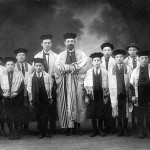Shabbat Shirah – the Shabbat of Song
The following article by Rabbi Raymond Apple originally appeared in the Australian Jewish News, 10 February 2017.
 This Shabbat is Shabbat Shirah because the centerpiece of the Torah reading is Shirat HaYam, the Song of the Sea sung by Moses, Miriam and the Children of Israel after their long period of bondage in Egypt.
This Shabbat is Shabbat Shirah because the centerpiece of the Torah reading is Shirat HaYam, the Song of the Sea sung by Moses, Miriam and the Children of Israel after their long period of bondage in Egypt.
The whole tradition of Jewish song is celebrated this Shabbat.
The musical component of the ceremonies in the Jerusalem Temple must have been remarkable, even though we have no records of its nature. A television producer in Australia was highly doubtful when I told him this. He was working on an Easter TV program about the Dead Sea Scrolls and came to me because someone had told him I could help with the background music, and what he wanted was specimens of Temple music. I still worry about whether he has forgiven me.
The Temple musicians were the Levites, whose modes were an amalgam of the vocal and instrumental. Look at the musical references in the Book of Psalms with its chorus of praise and its cries of lament, its meditative strummings and its full-throated instruments of triumph and joy.
Unlike the Orthodox synagogue of today, the Temple not only had a choir but an orchestra (Psalm 150 lists the instruments). When the Temple was destroyed, no-one could smile enough to sing the song of the Lord in a land of exile (Psalm 137 reflects their dilemma).
Musical instruments were now abandoned because the Temple setting existed no longer. Even at weddings, when nothing could hold back the swelling human emotion, the music had to be restricted. To this day there is a tradition that music should be restrained in Jerusalem, even on the occasion of a wedding.
Yet music came so naturally to human beings that it had to survive in some fashion, so its setting moved into the combination of synagogue, home and study hall.
Synagogue music took the form of Biblical cantillation, prayer chant, and later, choral singing. The cantillation depended on which Book was being read: there were separate melodies for the Chumash, the haftarot (readings from the prophets) and the Five Scrolls, the megillot. There were also musical settings for the Psalms.
There were cantillation differences between communities, especially Ashkenazim and Sephardim with sub-groups within each tradition. No-one is sure of the original tunes, though all use the same rhythm and pattern.
The differences between communities are particularly pointed when it comes to the haftarah. That’s why in most Israeli synagogues there can be a haftarah one week sung in the Eastern European tune, the next week in the Germanic/British mode, and the following week in Yemenite fashion where even the Hebrew pronunciation that is different.
The prayer chant – nussach – also shows diversity in unity. Every tradition has a musical theme for each occasion. The officiant might improvise or go off on a musical tangent and even bring in snatches of external melody, but he always returns to the standard mode.
Who, historically, was the officiant? The chazan was originally the synagogue overseer but became the resident liturgical expert. Originally lacking musical training, he became a professional precentor, sometimes developing amidst bitter criticism into a prima donna. In some places he was supported by a three-voice rudimentary choir. Eventually the choral music itself became an art form, and constant questions arose as to how to control the repertoire and the conduct of the choristers.
To this day one can often trace the influence of local folk song on the development of Jewish liturgical music. Tunes which are considered typically Jewish often turn out to be moulded by common melodies from the environment. Ma’oz Tzur and Addir Hu are examples. Enterprising chazanim these days bring in snatches from “Phantom of the Opera”, “Rigoletto” and so much else.
The story is told that in London 200 years ago someone complained to Chief Rabbi Solomon Hirschell that a certain cantor was imitating Don Juan, and the chief rabbi, totally unaware of contemporary music, responded that no-one should allow a person like that inside the synagogue.
Outside Israel cantorial music is still an art style. In British synagogues the “Blue Book” is still authoritative. Rabbinic robes have mostly disappeared, as have presidential top hats and morning coats, but cantorial caps are still in vogue though the cantorial profession is dying out. Israeli synagogues generally prefer quicker and less structured services, with lay officiants and a preference for Shlomo Carlebach styles.
At home, Shabbat and festivals bring music to the table. In a hostile world, the Jewish family became a sanctuary. If it was cold outside, the home was warm. Songs with snatches of popular melody passed down through the generations, especially in the long Grace After Meals and the Passover Haggadah. Everyone could join in, no matter that one lacked a singing voice, couldn’t hold a melody or was totally tone-deaf.
It is said that when Chabad Chassidim sang part of the Birkat HaMazon (Grace after Meals) to the tune of the French National Anthem, the rebbe said, “We didn’t take the tune from the French; they took it from us!”
In the study hall a Talmudic sing-song developed. As people studied together they dramatised the argument by raising, lowering, and varying their voice. Children’s versions of Mah Nishtanah mimicked the Talmudic melody. When we were learning Gemara at Jews’ College in London under the tutelage of the late Talmudic genius, Rabbi Kopel Kahana, the rabbi used to say, “You’ve got the words right, but the singing is wrong!”
All this is what we celebrate on Shabbat Shirah, the Sabbath of Song.



